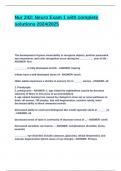Nur 242: Neuro Exam 1 with complete
solutions 2024/2025
The development of gross visual ability to recognize objects, perform purposeful
eye movements, and color recognition occur during the __________ year of life -
ANSWER- first
_________ is fully developed at birth - ANSWER- hearing
infants have a well-developed sense of - ANSWER- touch
Older adults experience a decline in sensory fxn in ______ senses - ANSWER- all
1. Presbyopia
2. presbycusis - ANSWER- 1. age related far sightedness caused by decrease
elasticity of fibers in lens (loss of accommodation)
2. age related hearing loss caused by changed in inner ear or nerve pathways to
brain; d/t earwax, TM atrophy, hair cell degeneration, ossicles calcify, brain
decreased ability to block unwanted sounds
Decreased ability to smell and distinguish btw smells typically starts at ______ yo
- ANSWER- 60
decreased sense of taste is commonly r/t decrease sense of ... - ANSWER- smell
Decreased sensation can lead to... - ANSWER- complications (frostbite, burns,
wounds)
_________ eye disorders include cataracts, glaucoma, retinal detachment, and
macular degeneration (direct cause of eye change) - ANSWER- Primary
,___________ eye disorders may be caused by DM, HTN, Diabetic retinopathy, and
congenital cataracts. - ANSWER- secondary
Ocular infection in 1st few weeks of life is _____ common among newborns.
Newborns receive erythromycin to prevent passing _______ from mom -
ANSWER- increasingly; STDs
The most prevalent type of hearing loss is? - ANSWER- sensorineural
changes in smell can be caused by _________, upper resp. infections, and
________ - ANSWER- chemo tx; dementia
Problems with touch can be caused by injury or trauma to the ___ or spinal cord,
or by progression of comorbid disease (for ex. _____) - ANSWER- head; diabetic
neuropathy
the population at the highest r/f changes in sensory perception? - ANSWER-
elderly
T or F: although congenital hearing loss is commonly the reason for problems of
the auditory system, > 50% of infants have no sig. risk factors - ANSWER- true
Ototoxicity from medications (ex. _____, _________) can result in permanent or
temporary inner ear problems that can affect hearing, balance, and ______. -
ANSWER- Lasix, gentamicin; speech
Taste disturbances can be caused by what drugs? - ANSWER- antibiotics, anti-
virals, antihypertensives, CCBs, diuretics
Paresthesias can be caused by what drugs - ANSWER- antiseizure, antineoplastic
Sensory Assessment:
1. Infants, when to start testing vision and what is used?
2. What is checked in infants regarding vision?
3. adult eye screening
4. infants hearing test
5. adults hearing test
6. numerator =
7. denominator =
8. ex. wht does 20/60 mean?
9. tonometry?
,10. Hearing issues in children (s/s)? - ANSWER- 1. at 3 yo start with snellen chart
2. eyetracing objects, PERRLA, external structures; at 6 mos cover test
3. less than or 40 yo done q 2yr; >60 done yearly
4. done w/in 48 h of birth, repeated in 1 mons if abnormal
5. only done when reports problems
6. distance that pt was standing at, always 20 ft
7. distance the average eye can read the same line
8. at 20 ft pt can see what the average person can see at 60 ft
9. measures pressure in eye by blowing air that slightly touches cornea
10. speech delay, trouble following directions, don't understand if speaking too
fast, cannot find the right words in convos
Cataract:
1. patho
2. etiology - ANSWER- 1. altered metabolic process within lens, leads to
accumulation of water and alterations in lens fiber structure = lens opacity and
vision changes (decreased visual acuity, scattered light)
2. usually age related (senile cataract), congenital factors like maternal rubella,
exposure to UV radiation, blunt/penetrating trauma, systemic corticosteroids,
ocular inflammation, and diabetes
Cataract: Health promotion
1. Prevention?
2. education regarding eye care
3. education regarding nutrition - ANSWER- 1. no proven way to prevent
2. sunglasses to avoid unnecessary radiation
3. antioxidant vitamins like C & E
Cataract: Dx findings
1. H & P
2. visual acuity measurement
3. ophthalmoscopy & slit lamp microscopy
4. glare testing
5. Keratometry & A-scan (if sx indicated) - ANSWER- 1. c/o visual dysfxn, glare,
altered colors, white pupil
2. decreased
3. opacity in lens observed
4. light scattering in light vs. dark enviros
5. measures corneal curvature & select correct lens implant
Cataract: sx management
, 1. phacoemulsification
2. extracapsular cataract extraction - ANSWER- 1. ultrasound probe dissolves
lens and then suctions pieces out; small, self-healing incision
2. lens removed whole; larger incision, requires sutures
*lens implant may be put during
Cataract: Preop care
1. Assess?
2. primary meds given & why
3. secondary meds
4. monitor for what r/t primary meds - ANSWER- 1. visual acuity, impact on
psychosocial, level of knowledge about disease, comfort & ability to follow
postop regimen
2. Mydriatics (pupil dilation) & cycloplegics/anticholinergics (paralysis of
accommodation & pupil dilation)
3. NSAIDs, topical antibiotics, antianxiety
4. toxicity: tachycardia, CNS effects
Cataract: Post op
1. goes home?
2. meds; teaching?
3. activity restrictions
4. expected outcomes teaching
5. monitor & report... - ANSWER- 1. usually when sedatives wear off
2. antibiotic & corticosteroids; wear sunglasses, eye patch
3. no bending down/over, stooping, coughing, lifting bc increases IOP; no driving
4. may initially experience a decrease in visual acuity
5. s/s of infection-fever, purulent drainageheaddueeufhf
Cataract: Acute care (sx)
1. initially may c/o? tx?
2. report to HCP
3. room lights?
4. eye patch risks
5. educate how long it may take for adequate visual acuity - ANSWER- 1.
scratchiness or blurred vision, mild analgesic
2. intense pain, bc may indicate hemorrhage, infection, increased IOP; also
purulent drainage, increase redness
3. dim bc photophobia from meds (dilation)
4. loss of depth perception (r.f injuries), move slow & carefully
5. 1-2 weeks, if worsens notify HCP




